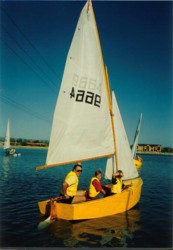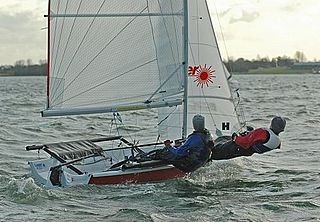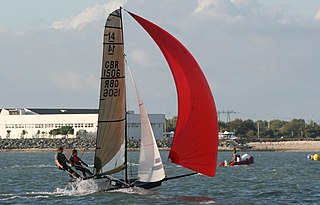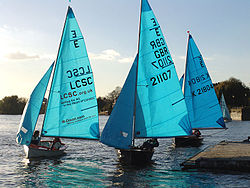
Dinghy sailing is the activity of sailing small boats by using five essential controls:
The Mirror is a popular sailing dinghy with more than 70,000 built.

The Heron Dinghy is a dinghy designed by Jack Holt of the United Kingdom as the Yachting World Cartopper. The Heron dinghy was designed to be built by a home handyman out of marine ply over a timber frame, but can now also be constructed from marine ply using a stitch and glue technique or from Fibreglass. Modern dinghies will usually have built in buoyancy tanks, older craft will have bags or retrofitted tanks.

The GP14 is a popular sailing dinghy, with well over 14,000 built.

The Wayfarer is a wooden or fibreglass hulled fractional Bermuda rigged sailing dinghy of great versatility; used for short 'day boat' trips, longer cruises and for racing. Over 11,000 have been produced as of 2016.

The 470 (Four-Seventy) is a double-handed monohull planing dinghy with a centreboard, Bermuda rig, and centre sheeting. Equipped with a spinnaker, trapeze and a large sail-area-to-weight ratio, it is designed to plane easily, and good teamwork is necessary to sail it well. The name comes from the boat's length of 470 centimetres.
Jack Holt, OBE was a prolific designer of sailing dinghies. His pioneering designs of dinghies using plywood did much to popularise the sport of sailing in the period immediately following World War II.

The International 420 Dinghy is a sailing dinghy popular for racing and teaching. The hull is fiberglass with internal buoyancy tanks. The 420 has a bermuda rig and an optional spinnaker and trapeze. It has a large sail-area-to-weight ratio, and is designed to plane easily. It can be rigged to be sailed single-handed or double-handed. The 420 is an International class recognized by World Sailing. The name refers to the boat's length of 420 centimetres.

The International 505 is a One-Design high-performance two-person monohull planing sailing dinghy, with spinnaker, utilising a trapeze for the crew.

The Manly Junior is a junior racing dinghy class popular in Sydney Australia. It was designed in 1959 for younger sailors and the length was originally designed so that the boat could be stored vertically downstairs inside Manly Yacht Club. To provide as much performance as possible in a short length, the designer, Ralph Tobias used a "snub" bow.

The Laser 4000 is a racing dinghy designed by Phil Morrison crewed by two persons. Its one-design weight-equalised system enables physically differing sailors to compete on a level playing field. It is most popular in Europe, particularly the UK, France and Italy.

The Jet 14 is an American sailing dinghy that was designed by Howard Siddons as a one-design racer and first built in 1952.

The Wanderer is a 14-foot Fibreglass hull Bermuda rigged sailing dinghy designed by Ian Proctor. One of the main objectives of the design was to produce a robust safe and versatile dinghy that could be used for knockabout day sailing and cruising as well as racing, but was light enough to be handled ashore.

The International 14 is a 14-foot double-handed racing dinghy. The class originated in England in the early part of the 20th century. It is sailed and raced in many countries around the world and was one of the first true international racing dinghy classes recognised by International Sailing Federation. It is a development class, being controlled by a set of rules that allow for innovation and changes in hull and rig design as long as they fall within a set of specific limitations such as length, weight, beam, and sail area. The class has permitted its rules to be revised at various times in its history in order to keep the class at the forefront of dinghy racing development and can now best be described as an ultralight dual-trapeze sailing dinghy with large sail area. It is often raced with boats of similar design in one-design, or non-handicap races.

Otter is a classification referring to a particular design for a two-man sailing dinghy with a glass fibre hull. Its rig consists of a main, a jib and an optional symmetric spinnaker. The hull dimensions are 11 ft 11 in length and 4 ft 10 in beam. The boat has a draft of 3 ft 6 in with the centreboard down. The sail area is 75 sq. ft. The class symbol is a stylised glass bubble; due to the original lightweight "cigar box cedar" construction of the prototypes, the name 'Bubble' was first used for the boat. John Baker obtained the plans for an expanded version of the boat in G.R.P. and hence renamed the boat 'Glass Bubble'. After being put into production by Baker, the name 'Otter' was adopted; coming from the river of the same name in East Devon, close to where the boat was manufactured.

The Cherub is a 12 feet long, high performance, two-person, planing dinghy first designed in 1951 in New Zealand by John Spencer. The class is a development class, allowing for significant variation in design between different boats within the rule framework. The minimum hull weight was originally 110 lbs.
The Pacer class of sailing dinghy, formerly known as the Puffin Pacer, was designed in the United Kingdom by Jack Holt. It was commissioned by Puffin Paints and Glues to be designed as sailing dinghy for use by families, so needing to be larger than their earlier Puffin dinghy. It has since become a popular learning and racing dinghy in Australia, Canada, the Netherlands, India and the UK. The name was changed in the UK early 1970s, although Australia continued to use the name until 1989, when they followed the UK in dropping the "puffin" and chose the wedge-tailed shearwater as the boat's symbol.

The Jacksnipe is a two-man racing sailing dinghy with a single trapeze for the crew and symmetrical spinnaker.

The Buzz is a sailing dinghy designed in 1994 by Ian Howlett and John Caig and manufactured by Reg White Limited of Brightlingsea as part of the "White Formula" range of boats originally marketed by Topper International Ltd but since 2013 by Vantage Sailing. The Buzz is a double handed racing boat, with a single trapeze for the crewman. The boat has a fully battened mainsail, furling jib and an asymmetrical spinnaker. There have been around 500 boats built. The Buzz is designed to be an easy to sail boat, but it can also be raced competitively.
ISO is an International Sailing Federation (ISAF) class of two-person sailing dinghy with a single trapeze and an asymmetric spinnaker. The ISO was designed in 1993 by Ian Howlett and John Caig and manufactured by Reg White Limited of Brightlingsea as part of the "White Formula" range of boats originally marketed by Topper International Ltd and since 2013 by Vantage Sailing Ltd. The boat has a fully battened mainsail, jib and an asymmetric spinnaker.

















